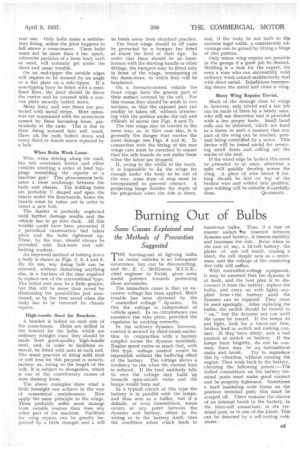Burning Out of Bulbs
Page 37

If you've noticed an error in this article please click here to report it so we can fix it.
Some Causes Explained and the Methods of Prevention Suggested
THE burning-out of lighting bulbs on motor vehicles is an infrequent occurrence, but can be disconcerting, and Mr. E. C. 'McKinnon, M.I.E.E., chief engineer to Exide, gives some useful pointers towards protecting these accessories.
The immediate cause is that an excessive voltage has been applied. Much trouble has been obviated by the "controlled voltage" dynamo. In this the voltage is independent of vehicle speed. In no circumstance can excessive rise lake place, provided the regulator be working correctly.
In the ordinary dynamo, however, control is secured by third-brush excitation in conjunction with a battery coupled across the dynamo terminals. Engine speed varies so much that, with this hype, voltage control would be imposiible without the buffering effect of thel battery. The voltage shows a tendency to rise when the current load is relced. If the load suddenly falls to ze o the voltage may build up towards open-circuit value and the lamps would burn out.
In a typical circuit of this type the battery is in parallel with the lamps, and thus acts as a buffer, but if a definite, or even intermittent, break occur it at any point between the dyna o and battery, either in the wiring or in the battery itself, then the condition arises which leads to burnt-out bulbs. Thus, if a fuse or master switch obe inserted between dynamo and battery, it lessens stability and increases the risk. Even when in the case of, say, a 12-volt battery, the plates of one cell touch, causing a short, the cell simply acts as a resistance, and the voltage of the remaining five cells will suffice.
With controlled-voltage equipment, it may be assumed that the dynamo is at fault, and the best plan is to disconnect it from the battery, replace the bulbs, and carry on with lights supplied from the battery until the dynamo can be repaired. They must be used sparingly., After replacing the bulbs, the switch should be turned to 'on," but the dynamo not run until the cause be traced. If the lamps do not light, look for a burnt-out fuse, broken lead or switch not making contact. If they burn dimly, seek a bad contact at switch or battery. If the lamps burn brightly, do not be content; there may be an intermittent
make and break. Try to reproduce • this by vibration, without running the engine. Then work back to the battery, checking the following points :—The bolted connections on the battery terminal posts must make good contact and be properly tightened. Sometimes a hard insulating scale forms on the positive terminal post; -this must be scraped off. There remains the chance of an internal break in the battery, in the inter-cell connectors, in the terminal post, or in one of the joints. This can be detected by a cell-testing voltmeter.




















































































